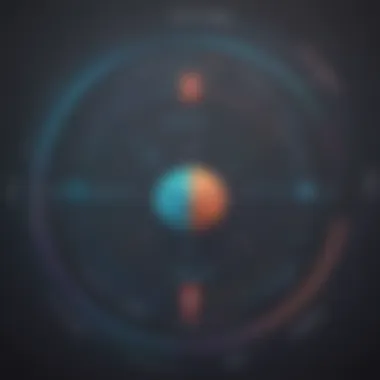Strategic Insights: Lucidchart & Venn Diagrams in Business Software Analysis


Software Overview
Lucidchart and Venn diagrams play a crucial role in business software analysis by providing visual representations that aid in decision-making processes. Lucidchart, a web-based diagramming tool, offers key features such as drag-and-drop functionality, collaboration options, and a vast library of templates tailored for business scenarios. The software provides various pricing plans, including a free basic version and several subscription options based on the user's needs.
User Experience
When it comes to user experience, Lucidchart boasts an intuitive user interface that facilitates easy navigation and seamless diagram creation. The learning curve is minimal, allowing users to quickly grasp the software's functionality. Additionally, Lucidchart offers reliable customer support options, including email assistance, tutorials, and a well-documented knowledge base to address any queries or issues.
Performance and Reliability
In terms of performance, Lucidchart excels in its speed and efficiency, enabling users to create complex diagrams with ease. The software boasts impressive uptime statistics, ensuring uninterrupted access for users. Moreover, Lucidchart integrates seamlessly with other tools such as Google Drive, Microsoft Office, and Dropbox, enhancing workflow efficiency.
Security and Compliance
Lucidchart prioritizes data security by implementing robust encryption protocols to safeguard user information. The software complies with industry regulations, ensuring data privacy and confidentiality. Additionally, Lucidchart offers backup and disaster recovery measures to prevent data loss and provide users with peace of mind regarding their information's safety.
Introduction
In this comprehensive article, we delve into the strategic utilization of Lucidchart and Venn diagrams in analyzing business software solutions. This exploration is tailored for small to medium-sized businesses, entrepreneurs, and IT professionals seeking optimal Saa S tools. The use of visual aids like Lucidchart and Venn diagrams holds significant importance in enhancing decision-making processes within the realm of business software analysis, offering a nuanced approach to evaluating and selecting the most suitable solutions.
Overview of Lucidchart
Lucidchart stands out as a versatile tool with a range of key features that set it apart in the realm of software analysis. One notable aspect of Lucidchart is its intuitive interface, allowing users to create intricate diagrams with ease. The collaborative nature of Lucidchart enables teams to work seamlessly on projects, promoting a more streamlined analysis process. Despite its many advantages, Lucidchart also comes with certain limitations, such as the complexity of certain diagram types that may require a learning curve for users.
Benefits of Using Lucidchart in Software Analysis


The benefits of utilizing Lucidchart in software analysis are manifold. One of the key attractions of Lucidchart is its cloud-based nature, allowing for real-time collaboration and easy access to diagrams from anywhere. Moreover, the extensive library of templates and shapes in Lucidchart simplifies the diagram creation process, saving valuable time for users. However, some might find the pricing of Lucidchart to be a deterrent, especially for smaller businesses with budget constraints.
Understanding Venn Diagrams
When it comes to business analysis, Venn diagrams play a crucial role in visualizing relationships and overlaps between different sets of data. The unique characteristic of Venn diagrams lies in their ability to showcase commonalities and distinctions with clarity. This visual aid proves beneficial in identifying patterns and intersections that might not be immediately apparent through textual analysis alone.
Types of Venn Diagrams
Various types of Venn diagrams cater to different analytical needs, such as symmetric, simple, and complex diagrams. Each type offers a distinct advantage depending on the nature of the data being analyzed. While symmetric Venn diagrams present a balanced view of relationships, complex diagrams delve deeper into multi-set analysis, providing a comprehensive perspective. It is essential to choose the appropriate type of Venn diagram based on the complexity of the software analysis being undertaken.
Application in Software Evaluation
Lucidchart in Action
Creating Software Comparison Charts
Creating Software Comparison Charts is a fundamental aspect of utilizing Lucidchart in software analysis. This process involves visually mapping out the features, functionalities, and performance metrics of different software solutions. By presenting this information in a structured chart format, businesses can easily compare and contrast various options to determine the most suitable one. Creating Software Comparison Charts in Lucidchart offers a user-friendly interface, customization options, and real-time collaboration features, making it a preferred choice for organizations looking to streamline their software evaluation process.
Mapping User Journeys
Mapping User Journeys using Lucidchart allows businesses to visualize the pathways that users take within a software application. This technique enables stakeholders to identify potential bottlenecks, optimize user experiences, and enhance overall usability. With Lucidchart's intuitive design tools and interactive capabilities, mapping user journeys becomes a seamless process. While this approach offers valuable insights into user interactions, it may require expertise to interpret and implement effectively in the software evaluation process.
Venn Diagrams for Decision Making
Identifying Software Features Overlaps
Venn Diagrams serve a crucial role in identifying software features overlaps during the decision-making process. By creating intersection areas that represent common features among different software solutions, businesses can prioritize essential functionalities and avoid redundancies. This visual representation aids in aligning business requirements with software capabilities, leading to more informed decision-making. While identifying software features overlaps through Venn Diagrams offers clarity and focus, it necessitates a comprehensive understanding of business needs and software functionalities.


Determining Compatibility
Utilizing Venn Diagrams to determine compatibility between various software solutions is vital in the evaluation process. By visually mapping out compatibility factors such as integration capabilities, system requirements, and scalability, businesses can assess the suitability of each software option. This approach streamlines the decision-making process by highlighting potential conflicts or synergies between different solutions. While determining compatibility through Venn Diagrams enhances decision-making efficiency, it requires detailed research and analysis to ensure accurate assessments.
Optimizing Software Selection
Optimizing Software Selection holds a crucial role in the realm of business software analysis. It serves as the cornerstone for making informed decisions regarding choosing the most suitable software solutions. By focusing on optimizing software selection, businesses can streamline their operations, enhance efficiency, and maximize productivity. Factors such as compatibility with existing systems, scalability, user-friendliness, and cost-effectiveness play pivotal roles in the selection process. Small to medium-sized businesses, entrepreneurs, and IT professionals benefit greatly from a strategic approach to software selection, ensuring that the chosen software aligns perfectly with their specific needs and objectives.
Lucidchart for Visualization
Creating Software Ecosystem Diagrams
Delving into Creating Software Ecosystem Diagrams within the context of business software analysis offers a unique perspective. These diagrams provide a comprehensive visual representation of how various software components interact with each other. The key characteristic of Creating Software Ecosystem Diagrams lies in their ability to simplify complex systems into easily digestible visuals, allowing stakeholders to grasp the interconnectedness of different software elements effortlessly. The unique feature of these diagrams is their capacity to highlight dependencies, data flows, and integration points, offering valuable insights for optimizing software selection. However, a potential disadvantage could be the challenge of maintaining real-time updates on dynamic ecosystems leading to potential inaccuracies if not regularly revised.
Illustrating Data Flows
Illustrating Data Flows plays a crucial role in enhancing the visualization of data movement across software systems. This aspect contributes significantly to the overall goal of analyzing business software solutions by providing clarity on how data is exchanged and processed within the software framework. The key characteristic of Illustrating Data Flows is its ability to identify bottlenecks, redundancies, and inefficiencies in data processing, enabling informed decision-making in software selection. This feature is a popular choice for its capacity to streamline data analysis processes and improve data integrity. However, a possible disadvantage could be overlooking certain intricate data flow patterns that may require more specialized visualization techniques.
Strategic Venn Diagram Usage
Comparing Pricing Plans
When it comes to Strategic Venn Diagram Usage in business software analysis, Comparing Pricing Plans emerges as a fundamental aspect. This comparison facilitates a clear overview of the cost structures associated with different software solutions, aiding in making cost-effective decisions. The key characteristic of Comparing Pricing Plans lies in its ability to juxtapose pricing models, features, and scalability options among various software offerings. This approach proves beneficial by allowing businesses to align their budgetary constraints with the features they prioritize in software selection. The unique feature of this practice is its capacity to reveal hidden costs or potential saving opportunities, enabling businesses to make informed financial decisions. However, a possible disadvantage could be oversimplifying the comparison, overlooking nuanced pricing details that may impact long-term costs.
Analyzing Feature Prioritization


Analyzing Feature Prioritization holds significant importance in the strategic use of Venn diagrams for business software analysis. This aspect aids in evaluating the essential features that different software solutions offer, assisting in narrowing down preferences based on critical requirements. The key characteristic of Analyzing Feature Prioritization is its ability to highlight key features, functionalities, and performance metrics that directly impact business operations. This approach is popular among businesses seeking to align software functionalities with their specific operational needs, ensuring optimal software selection. The unique feature of this analysis is its capacity to streamline decision-making processes by focusing on core features essential for business success. However, a potential disadvantage could be overlooking secondary features that may add supplementary value to the software solution.
Enhancing Decision-Making
In the realm of business software analysis, the process of decision-making holds paramount significance. Every choice made in selecting software solutions can impact the efficiency, productivity, and overall success of a business entity. Therefore, enhancing decision-making becomes a crucial aspect to consider when navigating the sea of available options. By delving into the depths of decision-making processes, one can uncover hidden insights, weigh the pros and cons meticulously, and align software choices with business goals for optimal results.
Lucidchart for Clarity
Simplifying Complex Software Structures
Simplifying complex software structures is a key functionality that Lucidchart offers in enhancing decision-making processes. The ability to break down intricate software components into digestible visual representations empowers users to grasp the underlying architecture with ease. By utilizing Lucidchart to simplify complex structures, businesses can streamline their analysis efforts, identify potential bottlenecks, and make informed decisions based on a clear understanding of the software ecosystem. This feature of Lucidchart not only saves time but also enhances the accuracy of decision-making by providing a comprehensive overview of the software landscape.
Visualizing Integration Possibilities
Another crucial aspect of Lucidchart for enhancing decision-making is its capability to visualize integration possibilities. By mapping out how different software components interconnect and interact, businesses can foresee potential integration challenges, synergies, and opportunities. This visualization feature allows stakeholders to foresee the impact of software implementations, plan for seamless integrations, and optimize the software ecosystem for enhanced performance. With Lucidchart's robust tools for visualizing integration possibilities, businesses gain a strategic advantage in making well-informed decisions that align with their organizational objectives.
Venn Diagrams for Insights
Highlighting Pros and Cons
Venn diagrams play a vital role in highlighting the pros and cons of various software solutions. By categorizing the features, functionalities, and drawbacks of different software options through Venn diagrams, businesses can conduct a comparative analysis that simplifies complex decision-making processes. The visual appeal of Venn diagrams makes it easy to identify overlapping features, unique advantages, and potential trade-offs, enabling stakeholders to prioritize requirements effectively. This feature of Venn diagrams offers a structured approach to evaluating software solutions, ensuring that decisions are made based on a thorough understanding of the comparative landscape.
Identifying Competitive Advantages
When it comes to gaining competitive advantages in software selection, Venn diagrams emerge as invaluable tools. By visually illustrating the unique selling points, market differentiators, and competitive strengths of various software offerings, businesses can pinpoint the ideal solution that aligns with their strategic objectives. The feature of identifying competitive advantages through Venn diagrams equips businesses with the insights needed to stay ahead of the competition, capitalize on market trends, and choose software solutions that foster growth and innovation. Through a systematic analysis of competitive advantages, businesses can make informed decisions that drive long-term success and sustainability.
Conclusion
S tools. Overall, the integration of visual aids like Lucidchart and Venn diagrams paves the way for a more efficient and effective software analysis approach, crucial in today's rapidly evolving digital landscape.
Harnessing Visual Tools for Software Decisions
- Summary of Benefits: The summary of benefits derived from utilizing visual tools like Lucidchart and Venn diagrams is monumental in this context. It simplifies complex software structures, allowing users to visualize integration possibilities and data flows seamlessly. Additionally, it aids in creating software ecosystem diagrams, offering a holistic view of interconnected processes. This feature contributes significantly to the overall goal of enhancing decision-making processes. Despite its advantages, users should be mindful of the learning curve associated with mastering these visual tools.
- Future Trends in Visual Analysis: Looking ahead, future trends in visual analysis hold immense promise for businesses delving into software evaluation. The key characteristic of these trends lies in their ability to offer advanced data visualization techniques and predictive analytics. This not only simplifies the decision-making process but also provides insights that go beyond traditional methods. Embracing these trends can give businesses a competitive edge, allowing them to stay at the forefront of technological advancements. However, it is essential to acknowledge the potential challenges in implementing these futuristic visual analysis tools and ensure proper training and integration strategies are in place.







